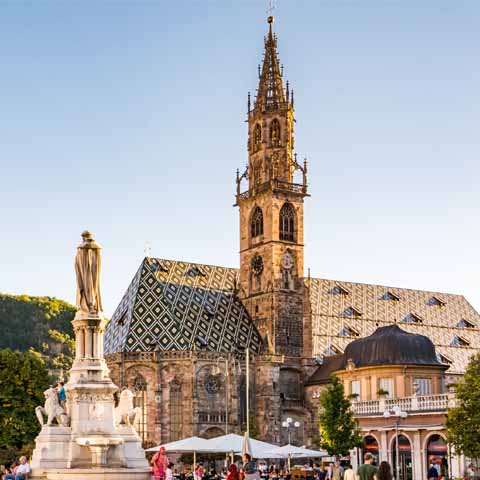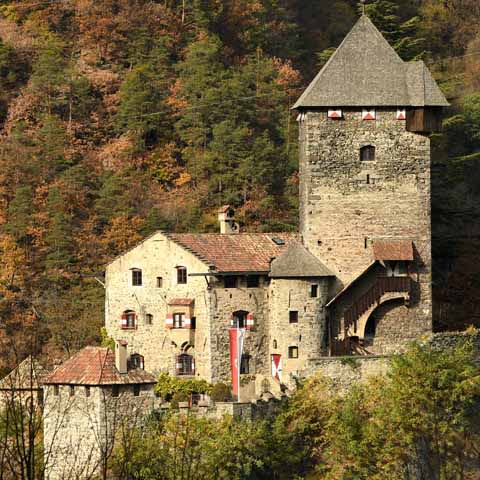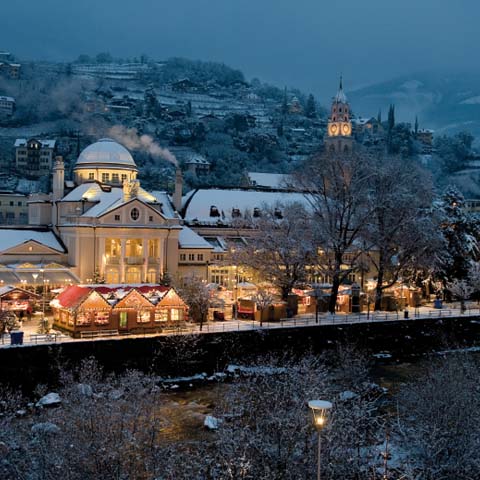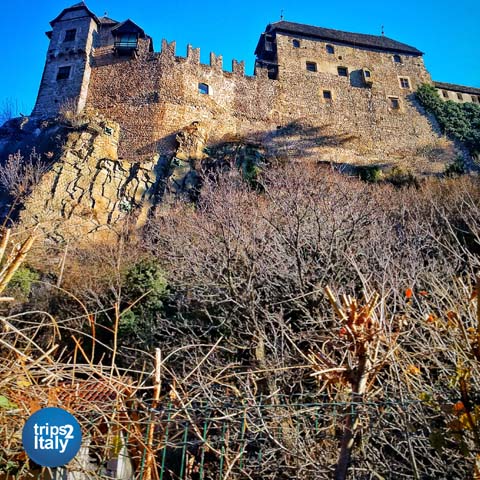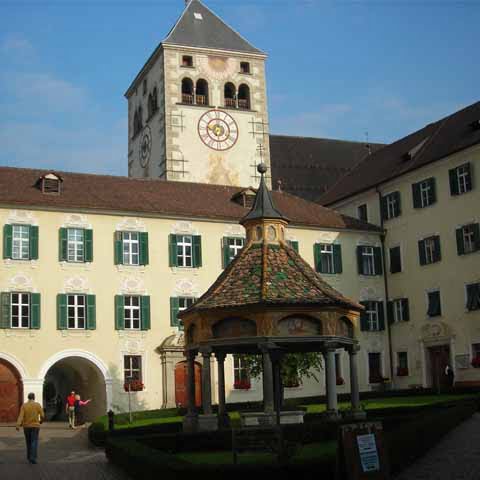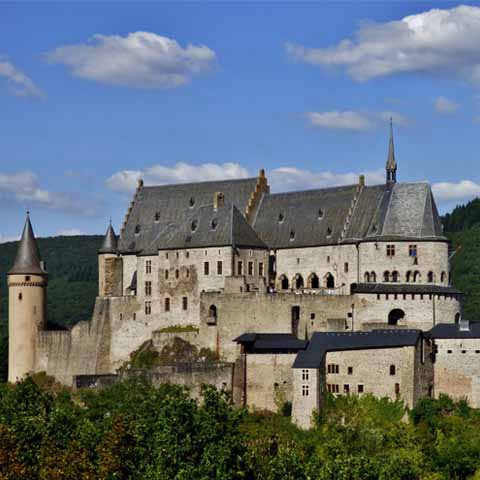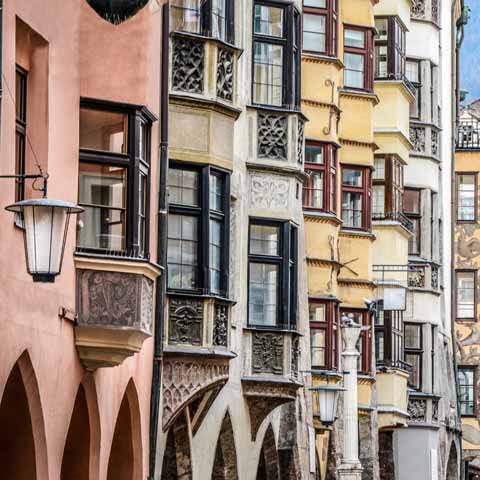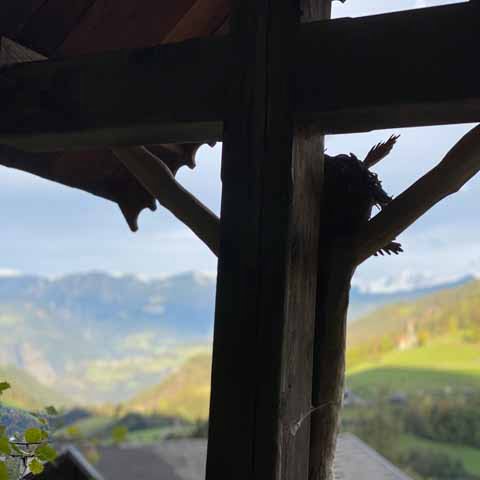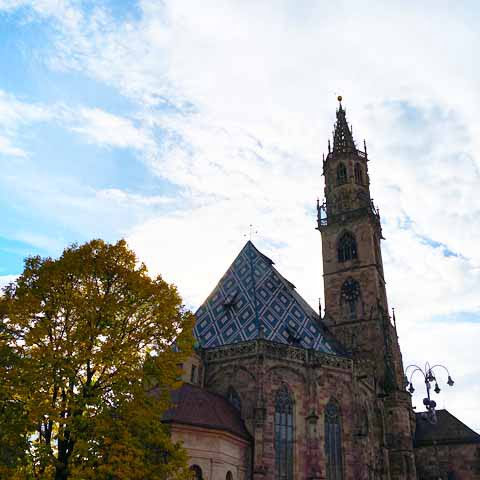Bolzano, the capital of Northern Italy’s province of South Tyrol, is a city defined by its numerous cultural influences, namely those of Italy, Austria, and Germany. Throughout its long history, Bolzano and South Tyrol have served as a crossroads between the Mediterranean and Germanic worlds. These influences can still be identified in the area’s languages, architecture, art, and cuisine.
Today the city is well known for hosting the Free University of Bozen-Bolzano and for the South Tyrol Museum of Archeology, which is the home of Ötzi, the oldest natural mummy discovered in Europe. Additionally, Bolzano has a thriving economy based on high-quality agriculture as well as artisan crafts and services. It is also consistently ranked among the best cities in Italy for quality of life. Travelers flock to Bolzano to discover the city’s rich architecture, unique culinary traditions, and breathtaking natural scenery featuring the stunning Dolomites.
PREHISTORY OF BOLZANO
The first certain information regarding the territory of Bolzano dates back to 15 BC when the General Nero Claudius Drusus built a settlement with a strategic and military function meant to control the junction between Via Brennero and Via Claudia Augusta.
This first Roman settlement had the name Pons Drusi (Drusus Bridge), after the general.
These roads later spurred local commerce, favoring the economic and cultural development of the region.
HISTORY OF BOLZANO
During the gradual decline of the Lombard influence in the seventh century, Bavarian immigration took place. German populations have been present in the region of Tyrol from that period onward. In the eighth century, the name Bauzanum appeared.
In 1027, the area of Bolzano and the rest of the diocese was conferred, by Emperor Conrad II from the Salian dynasty, upon the bishops of Trent. In the late-twelfth century, the bishop expropriated one of the many plots owned by religious orders and founded a market town.
The town therefore became an important trading post on the Transalpine Augsburg-Venice route over the Brenner Pass within the Holy Roman Empire. The market itself defined the economic, social, and cultural meaning of the city.
From the twelfth to the thirteenth centuries, Bolzano was surrounded by defensive walls. During the same period, the village was enriched with Gothic buildings, such as the Cathedral and the churches of the Franciscans and Dominicans.
In centuries that followed, the Gothic structure of the town did not undergo significant changes, so much so that it is still recognizable in the central Via dei Portici, a street-market with narrow and deep arcaded houses that combine residential and commercial functions. The mercantile wealth favored patronage and therefore the embellishment of the city.
In 1277, Meinhard II, the Count of Tyrol, conquered the city taking possession of most the lands belonging to the Prince Bishop of Trento. The walls and fortifications of the city were dismantled and the towers were demolished.
The Bishop gradually lost power, and in 1363, the County of Tyrol fell under the influence of Habsburg Austria and the Holy Roman Empire. In 1381, Duke Leopold granted the citizens of Bolzano the privilege of a town council. In 1462, the bishops resigned all their rights of jurisdiction over the town.
The heart of the merchant city remained the Marktgasse, a privileged place for trade and institutional life where the Laubenkönige, the rich Bolzano merchants, lived.
During the Middle Ages, Bolzano was known throughout Europe as the “City of the Four Fairs”, since it hosted annual markets of international importance. Fairs and markets took place four times during the year under the arcades, attracting numerous merchants both from Italy and from German-speaking countries.
It was also at this time that Bolzano was enriched with works from the Giotto school as well as masterpieces of Gothic art from beyond the Alps. This splendid blend of different styles made the city a bridge between cultures.
Bolzano suffered a severe blow to its commercial function when the war between the Habsburgs and the Venetian Republic compromised the free circulation of goods, heavily penalizing the Italian merchants, who were deprived of their citizenship by a new trade fair system of 1488.
The Mercantile Magistrate was therefore founded in 1634 by the Austrian Duchess Claudia de’ Medici. During every market season, two Italian and two Germanic officers, who were appointed by the local tradesmen, worked in this magistrate office. Thanks to the benefits of Claudian Privilege, the Bolzano fairs experienced a moment of renewed fortune.
New buildings arose and the old merchant houses were renovated according to the Baroque style of the time. Furthermore, Piazza delle Erbe acquired great vitality.
Bolzano was occupied several times by enemy armies Between 1774 and 1814. After centuries under the rule of Austria, South Tyrol was assigned first to the Bavarians (1805), then to the Napoleonic Kingdom of Italy (1809) with the name of the Department of Alto Adige, only to return under the Habsburg Austrian government in 1815.
Affected by the consequences of the Napoleonic Wars, Bolzano was deprived of the privileges and autonomy traditionally guaranteed by the market and was reduced to a small provincial town on the edge of the Empire.
During the nineteenth century, construction of the railways triggered a true economic boom, and the small medieval-looking center began to transform quickly. In 1859, the inauguration of the Südbahn, the railway section that connects Bolzano to Verona, was decisive for new urban planning and development.
The presence of civic architects already active beyond the Brenner Pass led Bolzano to participate in the most advanced urban planning culture. Monumental hotels and institutional sites such as the Town Hall, and the Civic Museum were built, while spectacular buildings and villas multiplied. Additionally, Bolzano’s tourist infrastructure was among the most modern in Europe.
Between 1843 and 1848, the first factories were inaugurated in Bolzano as well, exploiting the hydroelectric energy produced by the Talvera River.
When Italy declared war on Austria-Hungary on May 24, 1915, heavy fighting took place all along Tyrol’s southern border for the entire duration of the conflict. Tyrol’s southern frontier was — and still is — dotted with tens of defensive fortresses that had been built in view of a possible Italian attack.
With the armistice in 1918, Italian troops entered Tyrol and occupied the Austrian areas south of the Brenner Pass.
At the end of World War I, with the Treaty of Saint-Germain-en-Laye (1919) the Italian-Austrian border was brought to the Brenner Pass, with the annexation of the southern part of Tyrol to the Kingdom of Italy.
At the time of Bolzano’s annexation by the Kingdom of Italy, the town was settled primarily by a German-speaking population. In 1910, 29,000 inhabitants identified themselves as German speakers and only 1,300 as Italian speakers, with the latter mainly from the Italian speaking areas of Tyrol, namely Welschtirol, currently known as Trentino. Subsequently, Bolzano was subjected to an intensive Italianization process enforced by fascist leader Benito Mussolini.
With the establishment of the new province, the first phase of strong immigration of the Italian population began. The goal was to outnumber the local German-speaking population by tripling Bolzano’s population through Italian immigration from other regions of Italy.
Mussolini’s initiative included the development of industries, in particular in the field of hydroelectric energy, which is important for the processing of steel and magnesium.
Vast areas of agricultural land were expropriated to build large factories, roads, and houses for laborers. In the city center, instead, more prestigious accommodations were built for office workers and managers.
The center of Bolzano experienced a period of great urban growth, while the majority of the population of the provincial territory remained clearly of German language and culture.
In 1927, Bolzano became the capital of the province of Bolzano. Any reference to and use of the words Tyrol and Tyrolean were banned by law and were punishable offences.
In 1933, Adolf Hitler came to power in Germany. Mussolini and the fascists worried that Hitler, in pursuing his ideology of all ethnic Germans under one Reich, would claim South Tyrol from Italy.
To avoid such a prospect, in 1939 Mussolini and Hitler agreed that Germany would renounce territorial claims over South Tyrol as Germany’s Lebensraum (living space). The transfer of the local German-speaking population to the new territories occupied by Hitler was favored.
Ethnic South-Tyroleans who opted to stay in South Tyrol and refused resettlement to the Third Reich were subjected to full-scale Italianization, including loss of their German names and national identity as well as prohibition of schooling in German and the use of German for daily transactions.
World War II marked Bolzano with Anglo-American bombings. Bolzano was also the site of a Nazi concentration camp for persecuted Jews and political prisoners. Heavy fighting against Nazi Germany and the Allied Powers took place in the Dolomites.
After the armistice between the Italian government and the Allies on September 8, 1943, Bolzano was incorporated into the Alpenvorland, which the Gauleiter Hofer governed from Innsbruck.
After World War II, the Gruber-De Gasperi Agreement of September 1946 was signed by the Italian and Austrian Foreign Ministers in Paris, guaranteeing “complete equality of rights” (including education and use of German as an official language) as well as “autonomous legislative and executive regional power” to the German-speaking population in South Tyrol and Trentino.
In 1971, a new statute of autonomy for the small German-speaking province Bozen – Südtirol/Bolzano – Alto Adige, which was supported by the German-speaking population of South Tyrol, was granted by Italy. As a result, a considerable level of self-government was reached.
Today, Bolzano has become one of Northern Italy’s highly-regarded travel destinations.
ARCHAEOLOGY IN BOLZANO
Unique in the world, Bolzano boasts the mummy of Ötzi the Iceman, our ancestor from more than 5,000 years ago, who arrived in an excellent state of conservation from the Copper Age up to the present day after being frozen in a glacier for millennia.
In 1991, Ötzi was discovered by chance by a pair of hikers with his clothing and equipment on the Val Senales glacier. Today, Ötzi is housed at the South Tyrol Museum of Archeology in a special cell and can be viewed through a small window.
The Museum Pons Drusi hosts exceptional Roman ruins that date back to the first century AD. The large structure, which features frescoes and colonnades, likely served as a base for a monument or temple.
On the site of Bolzano’s Cathedral, the ruins of a Paleo Christian basilica, believed to be from the fourth century, have been discovered. An Ancient Roman cemetery has come to light as well. The cemetery holds the third century tomb of one “Secundus Regontius”, who is Balzano’s oldest former citizen.
Don't just see Italy, live it.
Your dream trip to Italy has never been closer
No more endlessly scrolling travel sites. Our travel experts will craft the perfect, one-of-a-kind trip just for you.

300+
DESTINATIONS
We offer more Italian destinations than any travel site. Do and see more with Trips 2 Italy.
1 (of a kind)
ITINERARIES
Because your dream trip to Italy should be designed for you, not for the masses.
100%
PEACE OF MIND
From flights and accommodations, to food and activities - we take care of every detail.
